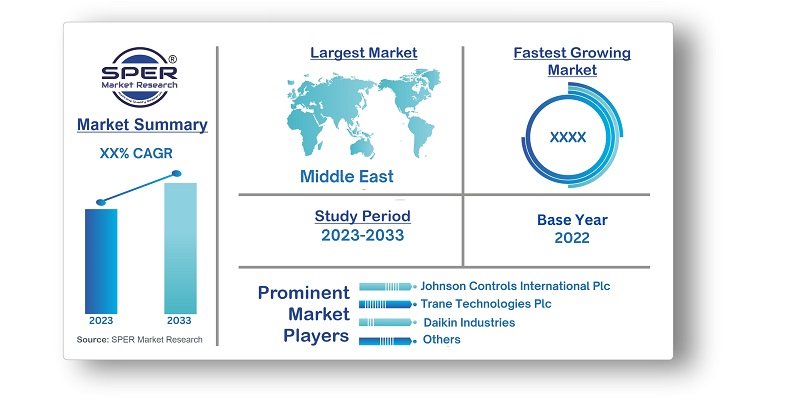
Saudi Arabia HVAC Market Growth, Trends, Size, Scope, Challenges and Future Competition Till 2033
Saudi Arabia HVAC Market Size- By Equipment, By Implementation Type, By End User- Regional Outlook, Competitive Strategies and Segment Forecast to 2033
| Published: May-2023 | Report ID: IACT23103 | Pages: 1 - 103 | Formats*: |
| Category : Information & Communications Technology | |||


| Report Metric | Details |
| Market size available for years | 2019-2033 |
| Base year considered | 2022 |
| Forecast period | 2023-2033 |
| Segments covered | By Equipments, By Implementation Type, By End Use |
| Regions covered | Northern, Central, Western, Eastern |
| Companies Covered | Johnson Controls International Plc, Lg Electronics, Mitsubishi Electric Corporation, Gree Electric Appliances Inc, Trane Technologies Plc, Danfoss A/S, Carrier Global Corporation, Midea Group Co. Ltd, Daikin Industries, Zamil Air Conditioners |
- Contractors
- Builders
- Property Managers
- Government agencies
- Warehouses
- Residential
- Commercial
- Saudi Arabia HVAC Market Value Share and Forecast, By Equipment, 2023-2033
- Heating
- Ventilation
- Cooling
- Saudi Arabia HVAC Market Value Share and Forecast, By Implementation Type, 2023-2033
- New Constructions
- Retrofits
- Saudi Arabia HVAC Market Value Share and Forecast, By End Use, 2023-2033
- Residential
- Commercial
- Industrial
- Northern
- Central
- Western
- Eastern
- Saudi Arabia HVAC Market Size (FY’2023-FY’2033)
- Overview of Saudi Arabia HVAC Market
- Segmentation of Saudi Arabia HVAC Market By Equipment (Heating, Ventilation, Cooling)
- Segmentation of Saudi Arabia HVAC Market By Implementation Type (New Constructions, Retrofits)
- Segmentation of Saudi Arabia HVAC Market By End Use (Residential, Commercial, Industrial)
- Statistical Snap of Saudi Arabia HVAC Market
- Growth Analysis of Saudi Arabia HVAC Market
- Problems and Challenges in Saudi Arabia HVAC Market
- Competitive Landscape in the Saudi Arabia HVAC Market
- Impact of COVID-19 and Demonetization on Saudi Arabia HVAC Market
- Details on Recent Investment in Saudi Arabia HVAC Market
- Competitive Analysis of Saudi Arabia HVAC Market
- Key Players in the Saudi Arabia HVAC Market
- SWOT Analysis of Saudi Arabia HVAC Market
- Saudi Arabia HVAC Market Future Outlook and Projections (FY’2023-FY’2033)
- Recommendations from Analyst
1.1. Scope of the report1.2. Market segment analysis
2.1. Research data source2.1.1. Secondary Data2.1.2. Primary Data2.1.3. SPER’s internal database2.1.4. Premium insight from KOL’s2.2. Market size estimation2.2.1. Top-down and Bottom-up approach2.3. Data triangulation
4.1. Driver, Restraint, Opportunity and Challenges analysis4.1.1. Drivers4.1.2. Restraints4.1.3. Opportunities4.1.4. Challenges4.2. COVID-19 Impacts of the Saudi Arabia HVAC Market
5.1. SWOT Analysis5.1.1. Strengths5.1.2. Weaknesses5.1.3. Opportunities5.1.4. Threats5.2. PESTEL Analysis5.2.1. Political Landscape5.2.2. Economic Landscape5.2.3. Social Landscape5.2.4. Technological Landscape5.2.5. Environmental Landscape5.2.6. Legal Landscape5.3. PORTER’s Five Forces5.3.1. Bargaining power of suppliers5.3.2. Bargaining power of buyers5.3.3. Threat of Substitute5.3.4. Threat of new entrant5.3.5. Competitive rivalry5.4. Heat Map Analysis
6.1. Saudi Arabia HVAC Market Manufacturing Base Distribution, Sales Area, Product Type6.2. Mergers & Acquisitions, Partnerships, Product Launch, and Collaboration in Saudi Arabia HVAC Market
7.1. Saudi Arabia HVAC Market Value Share and Forecast, By Equipment, 2023-20337.2. Heating7.2.1. Heat Pumps7.2.2. Furnaces7.2.3. Unitary Heating7.3. Ventilation7.3.1. Air-handling Units7.3.2. Ventilation Fans7.3.3. Dehumidifiers and Humidifiers7.3.4. Others7.4. Cooling7.4.1. Unitary Air Conditioners7.4.2. VRF Systems7.4.3. Chillers7.4.4. Coolers7.4.5. Cooling Towers7.4.6. Others
8.1. Saudi Arabia HVAC Market Value Share and Forecast, By Implementation Type, 2023-20338.2. New Constructions8.3. Retrofits
9.1. Saudi Arabia HVAC Market Value Share and Forecast, By End Use, 2023-20339.2. Residential9.3. Commercial9.4. Industrial
10.1. Saudi Arabia HVAC Market Size and Market Share
11.1. Saudi Arabia HVAC Market Size and Market Share by Equipment (2019-2026)11.2. Saudi Arabia HVAC Market Size and Market Share by Equipment (2027-2033)
12.1. Saudi Arabia HVAC Market Size and Market Share by Implementation Type (2019-2026)12.2. Saudi Arabia HVAC Market Size and Market Share by Implementation Type (2027-2033)
13.1. Saudi Arabia HVAC Market Size and Market Share by End Uses (2019-2026)13.2. Saudi Arabia HVAC Market Size and Market Share by End Uses (2027-2033)
14.1. Saudi Arabia HVAC Market Size and Market Share by Region (2019-2026)14.2. Saudi Arabia HVAC Market Size and Market Share by Region (2027-2033)14.3. Northern14.4. Central14.5. Western14.6. Eastern
15.1. Johnson Controls International Plc.15.1.1. Company details15.1.2. Financial outlook15.1.3. Product summary15.1.4. Recent developments15.2. LG Electronics Inc.15.2.1. Company details15.2.2. Financial outlook15.2.3. Product summary15.2.4. Recent developments15.3. Mitsubishi Electric Corporation15.3.1. Company details15.3.2. Financial outlook15.3.3. Product summary15.3.4. Recent developments15.4. Gree Electric Appliances Inc15.4.1. Company details15.4.2. Financial outlook15.4.3. Product summary15.4.4. Recent developments15.5. Trane Technologies Plc15.5.1. Company details15.5.2. Financial outlook15.5.3. Product summary15.5.4. Recent developments15.6. Danfoss A/S15.6.1. Company details15.6.2. Financial outlook15.6.3. Product summary15.6.4. Recent developments15.7. Carrier Global Corporation15.7.1. Company details15.7.2. Financial outlook15.7.3. Product summary15.7.4. Recent developments15.8. Midea Group Co. Ltd15.8.1. Company details15.8.2. Financial outlook15.8.3. Product summary15.8.4. Recent developments15.9. Daikin Industries15.9.1. Company details15.9.2. Financial outlook15.9.3. Product summary15.9.4. Recent developments15.10. Zamil Air Conditioners15.10.1. Company details15.10.2. Financial outlook15.10.3. Product summary15.10.4. Recent developments
SPER Market Research’s methodology uses great emphasis on primary research to ensure that the market intelligence insights are up to date, reliable and accurate. Primary interviews are done with players involved in each phase of a supply chain to analyze the market forecasting. The secondary research method is used to help you fully understand how the future markets and the spending patterns look likes.
The report is based on in-depth qualitative and quantitative analysis of the Product Market. The quantitative analysis involves the application of various projection and sampling techniques. The qualitative analysis involves primary interviews, surveys, and vendor briefings. The data gathered as a result of these processes are validated through experts opinion. Our research methodology entails an ideal mixture of primary and secondary initiatives.



Frequently Asked Questions About This Report
PLACE AN ORDER
Year End Discount
Sample Report
Pre-Purchase Inquiry
NEED CUSTOMIZATION?
Request CustomizationCALL OR EMAIL US
100% Secure Payment






Related Reports
Our Global Clients
Our data-driven insights have influenced the strategy of 200+ reputed companies across the globe.




















